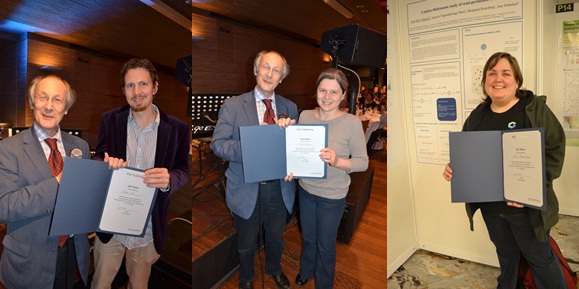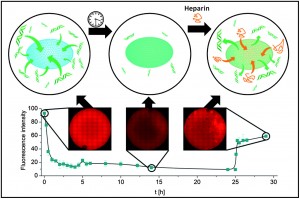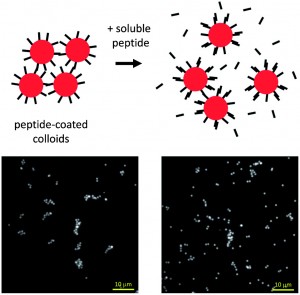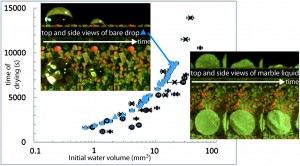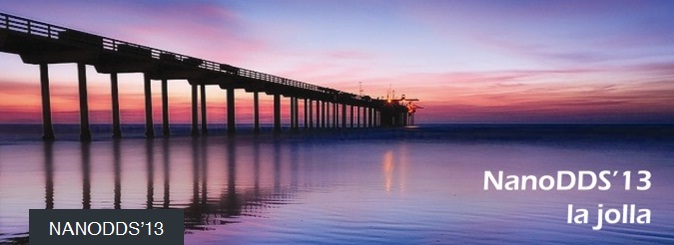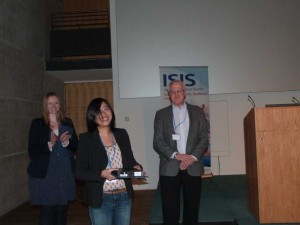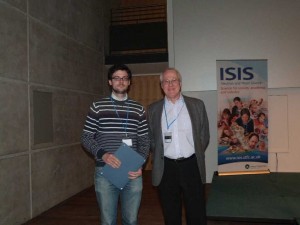-
Matthew Blow – Flexoelectric and order-electric switching between nematic wetting morphologies
Universidade de Lisboa, PortugalVera de Oliveira Batista – A lattice-Boltzmann study of semi-permeable colloids
University of Ljubljana, SloveniaIoana Vladescu – Micro-swimmers confined to a sphere
The University of Edinburgh, UKEach student received a Soft Matter Poster Prize certificate as well as 1 year electronic subscription to the journal.
Conference Physics of Complex Colloids – Soft Matter Poster Prize Winners
Top 10 most-read Soft Matter articles in March
This month sees the following articles in Soft Matter that are in the top ten most accessed for March:
Solvent-assisted poly(vinyl alcohol) gelated crystalline colloidal array photonic crystals
Cheng Chen, Yihua Zhu, Hua Bao, Peng Zhao, Hongliang Jiang, Liming Peng, Xiaoling Yang and Chunzhong Lia
Soft Matter, 2011,7, 915-921
DOI: 10.1039/C0SM00923G
Extreme wettability and tunable adhesion: biomimicking beyond nature?
Xinjie Liu, Yongmin Liang, Feng Zhou and Weimin Liu
Soft Matter, 2012,8, 2070-2086
DOI: 10.1039/C1SM07003G
A review of fundamental properties and applications of polymer–graphene hybrid materials
Alison Y. W. Sham and Shannon M. Notley
Soft Matter, 2013, Advance Article
DOI: 10.1039/C3SM00092C
Modified gellan gum hydrogels for tissue engineering applications
Cameron J. Ferris, Kerry J. Gilmore, Gordon G. Wallace and Marc in het Panhuis
Soft Matter, 2013,9, 3705-3711
DOI: 10.1039/C3SM27389J
Bacteria–surface interactions
Hannah H. Tuson and Douglas B. Weibel
Soft Matter, 2013,9, 4368-4380
DOI: 10.1039/C3SM27705D
Stimuli-responsive hydrogels cross-linked by magnetic nanoparticles
Patrick Ilg
Soft Matter, 2013,9, 3465-3468
DOI: 10.1039/C3SM27809C
Emergent colloidal dynamics in electromagnetic fields
Jure Dobnikar, Alexey Snezhko and Anand Yethiraj
Soft Matter, 2013,9, 3693-3704
DOI: 10.1039/C3SM27363F
Complexes of oppositely charged polyelectrolytes and surfactants – recent developments in the field of biologically derived polyelectrolytes
Leonardo Chiappisi, Ingo Hoffmanna and Michael Gradzielski
Soft Matter, 2013,9, 3896-3909
DOI: 10.1039/C3SM27698H
Tunable and dynamic soft materials for three-dimensional cell culture
Matthew S. Rehmann and April M. Kloxin
Soft Matter, 2013, Advance Article
DOI: 10.1039/C3SM50217A
Single amino acid based thixotropic hydrogel formation and pH-dependent morphological change of gel nanofibers
Jayanta Nanda, Abhijit Biswas and Arindam Banerjee
Soft Matter, 2013,9, 4198-4208
DOI: 10.1039/C3SM27050E
Why not take a look at the articles today and blog your thoughts and comments below.
Fancy submitting an article to Soft Matter? Then why not submit to us today!
To keep up-to-date with all the latest research, sign up for the Soft Matter e-Alert or RSS feeds or follow Soft Matter on Twitter or Facebook
May’s hot papers
These papers are HOT as recommended by referees. All are free to read for 4 weeks!
Cationic poly(2-oxazoline) hydrogels for reversible DNA binding
Matthias Hartlieb, David Pretzel Kristian Kempe, Carolin Fritzsche, Renzo M. Paulus, Michael Gottschaldt and Ulrich S. Schubert
Tuning colloidal association with specific peptide interactions
Alia P. Schoen, Bob Hommersom, Sarah C. Heilshorn and Mirjam E. Leunissen
How coatings with hydrophobic particles may change the drying of water droplets: incompressible surface versus porous media effects
Benoît Laborie, Florent Lachaussée, Elise Lorenceau and Florence Rouyer
NanoDDS’13: Oct. 25-26, 2013 – University of California, San Diego
The 11th International Nanomedicine and Drug Delivery Symposium (NanoDDS’13) will be held Oct. 25-26, 2013 at the University of California, San Diego. NanoDDS is the key annual event for researchers developing next-generation delivery vehicles: targeted, responsive, biodegradable nanomaterials for drug delivery, diagnostics, noninvasive imaging, and regenerative medicine. This symposium, co-chaired by Adah Almutairi of UC San Diego and Andrew Mackay of the University of Southern California, features a diverse group of creative, high-profile investigators, including Erkki Ruoslahti, Samuel Stupp, and Allan Hoffman.
Abstracts for poster presentations will be accepted from May through September; the top three abstracts will win prizes and oral presentation slots.
More information can be found here.
Announcing Eric M. Furst as the 2013 Soft Matter Lectureship recipient
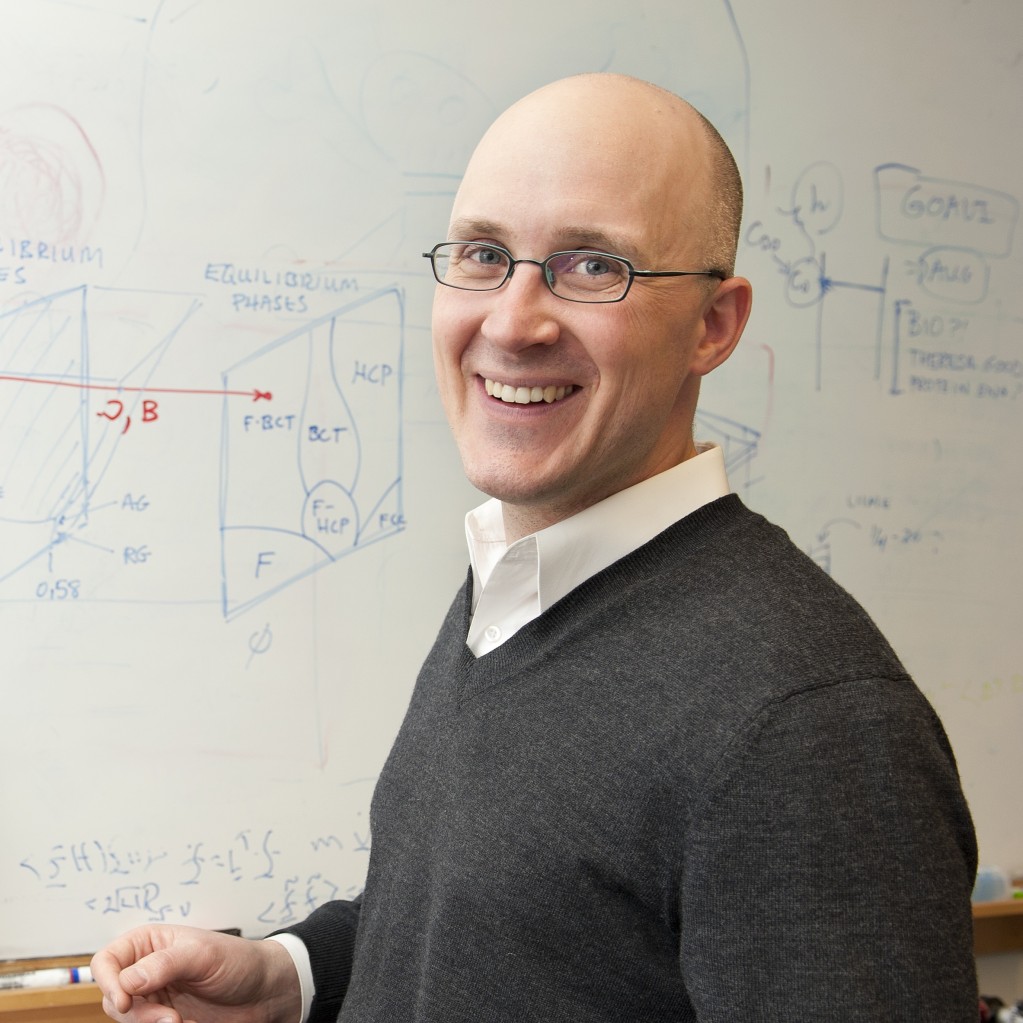 The Soft Matter Editorial Board have chosen Professor Eric M. Furst as the recipient of this year’s Soft Matter Lectureship. This annual Lectureship was established by the journal in 2009 to honour a younger scientist who has made a significant contribution to the soft matter field. We would like to thank everyone who nominated someone – as always there was an excellent group of candidates – and congratulate Professor Furst.
The Soft Matter Editorial Board have chosen Professor Eric M. Furst as the recipient of this year’s Soft Matter Lectureship. This annual Lectureship was established by the journal in 2009 to honour a younger scientist who has made a significant contribution to the soft matter field. We would like to thank everyone who nominated someone – as always there was an excellent group of candidates – and congratulate Professor Furst.
Eric M. Furst is a Professor of Chemical and Biomolecular Engineering and Director of the Center for Molecular Engineering and Thermodynamics at the University of Delaware. Furst received his BS with University Honors in Chemical Engineering from Carnegie Mellon University, his PhD from Stanford University, and afterwards studied biophysics as a Chateaubriand postdoctoral fellow at Institut Curie, Paris. His interests span a wide range of topics in soft matter science and engineering, but focus in particular on the physics and chemistry of the colloidal domain. Furst’s research group is recognized for their contributions to active and passive microrheology, biomaterial rheology, interfacial phenomena, directed self-assembly of colloids and nanoparticles, and colloid electrokinetics.
Top 10 most-read Soft Matter articles in February
This month sees the following articles in Soft Matter that are in the top ten most accessed for February:
Directed self-assembly of block copolymers for universal nanopatterning
Bong Hoon Kim , Ju Young Kim and Sang Ouk Kim
Soft Matter, 2013,9, 2780-2786
DOI: 10.1039/C2SM27535J
Protein–polyelectrolyte interactions
A. Basak Kayitmazer , Daniel Seeman , Burcu Baykal Minsky , Paul L. Dubin and Yisheng Xu
Soft Matter, 2013,9, 2553-2583
DOI: 10.1039/C2SM27002A
Extreme wettability and tunable adhesion: biomimicking beyond nature?
Xinjie Liu , Yongmin Liang , Feng Zhou and Weimin Liu
Soft Matter, 2012,8, 2070-2086
DOI: 10.1039/C1SM07003G
Nanoemulsions versus microemulsions: terminology, differences, and similarities
David Julian McClements
Soft Matter, 2012,8, 1719-1729
DOI: 10.1039/C2SM06903B
Hybrid raspberry microgels with tunable thermoresponsive behavior
Jean-François Dechézelles , Vikash Malik , Jérôme J. Crassous and Peter Schurtenberger
Soft Matter, 2013,9, 2798-2802
DOI: 10.1039/C3SM27433K
Design and properties of supramolecular polymer gels
Atsushi Noro , Mikihiro Hayashi and Yushu Matsushita
Soft Matter, 2012,8, 6416-6429
DOI: 10.1039/C2SM25144B
Stimuli-responsive surfactants
Paul Brown , Craig P. Butts and Julian Eastoe
Soft Matter, 2013,9, 2365-2374
DOI: 10.1039/C3SM27716J
Gel-nanocomposites: materials with promising applications
Dibyendu Das , Tanmoy Kar and Prasanta Kumar Das
Soft Matter, 2012,8, 2348-2365
DOI: 10.1039/C1SM06639K
Stimuli-responsive hydrogels cross-linked by magnetic nanoparticles
Patrick Ilg
Soft Matter, 2013,9, 3465-3468
DOI: 10.1039/C3SM27809C
Mechanics of morphological instabilities and surface wrinkling in soft materials: a review
Bo Li , Yan-Ping Cao , Xi-Qiao Feng and Huajian Gao
Soft Matter, 2012,8, 5728-5745
DOI: 10.1039/C2SM00011C
Why not take a look at the articles today and blog your thoughts and comments below.
Fancy submitting an article to Soft Matter? Then why not submit to us today!
To keep up-to-date with all the latest research, sign up for the Soft Matter e-Alert or RSS feeds or follow Soft Matter on Twitter or Facebook.
Peter Schurtenberger joins the Soft Matter Editorial Board
 We are delighted to welcome Peter Schurtenberger to the Soft Matter Editorial Board.
We are delighted to welcome Peter Schurtenberger to the Soft Matter Editorial Board.
Peter Schurtenberger is currently a professor at the Division of Physical Chemistry, Lund University, Sweden. His research interests focus on colloidal soft matter, nanotechnology, biophysics, materials sciences and food technology, on the characterization of soft matter with scattering methods and on the development of new instruments for this task.
Schurtenberger received his PhD in physics from ETH Zurich in 1984, worked as a postdoc at Lund University and MIT, and as a senior researcher at the Department of Materials of ETHZ. In 1999 he was appointed as the chair in experimental physics at the University of Fribourg, where he became the founding director of the Adolphe Merkle Institute and received a chair in Experimental Physics and Nanoscience in 2008. He moved to Lund University at the end of 2010.
His recent publications include:
Fluid–solid transitions in soft-repulsive colloids
Soft Matter, 2013, 9, 3000-3004
Hybrid raspberry microgels with tunable thermoresponsive behavior
Soft Matter, 2013, 9, 2798-2802
Deformable particles with anisotropic interactions: unusual field-induced structural transitions in ultrasoft ionic microgel colloids
Soft Matter, 2012, 8, 10819-10822
Preparation and characterization of ellipsoidal-shaped thermosensitive microgel colloids with tailored aspect ratios
Soft Matter, 2012, 8, 3538-3548
Themed issue on Reconfigurable soft matter
Soft Matter and guest editors Joanna Aizenberg (Harvard University) and Anna Balazs (University of Pittsburgh) are planning to produce a themed issue on ‘Reconfigurable soft matter’.
From the guest editors:
“This issue will focus on experimental, theoretical and computer simulation studies of soft, reconfigurable materials. A distinctive feature of these systems is their ability to sense and respond to external stimuli or changes in the environment by readjusting their morphology and/or functionality. Examples abound in biology since this adaptive behaviour is vital for survival. Consider, for the example, the ability of the octopus and cuttlefish to change their colour and texture in the presence of their predators, and thus camouflage their identity. In order to accomplish analogous adaptive behaviour, synthetic systems typically encompass a coupling between mechanical and chemical, electrical, optical or thermal behaviour. For instance, certain photo-responsive gels mechanically shrink or swell in the presence of light, and by exploiting this property, the gels can be driven to undergo controllable shape changes. Our goal is to highlight the new advances in designing and creating such reconfigurable materials. Advances in this area could lead to new multi-functional systems, which display one structure and function in one environment, but display another shape and function under different conditions. As a friend of ours likes to joke, an umbrella provides a prime example of this behaviour – in the absence of rain, it remains folded and could act as a walking stick; however, in the presence of rain, it becomes unfolded and keeps the user dry. We seek other remarkable examples of such useful adaptation.”
The deadline for receipt of manuscripts for this themed is 14 June 2013
Manuscripts can be submitted using the RSC’s online submissions service. Please clearly mark that the manuscript is submitted for the themed issue on ‘Reconfigurable soft matter’.
Please would you inform the editorial office by e-mail as soon as possible if you plan to submit to the issue and whether your contribution will be original research or a review-type article. We would like to have a list of authors who intend to contribute as soon as possible.
The Impact and Future of Scattering Techniques in Soft Matter Conference – Soft Matter Poster Prize Winners
First prize:
Miss Wanatchaporn Arunmanee
“Unravelling the interaction of bacterial toxin with the specific receptor by EM and neutron scattering”
W. Arunmanee, A. Solovyova, C.L. Johnson, H. Ridley, J.R. Harris, R.K. Heenan, and J.H. Lakey
Second prize:
Dr Zoltan Varga
“Structural characterization of sterically stabilized liposomes used as drug delivery systems by means of small-angle scattering techniques”
Zoltán Varga, Attila Bóta
Each student received a Soft Matter Poster Prize certificate as well as 1 year electronic subscription to the journal. The first prize winner was also awarded a Kindle Fire kindly donated by the Diamond Light Source.
Discussing soft matter education
A collection of Editorials on soft matter education & a home for community led discussion
Soft Matter has recently published online a series of Editorials by Samuel A. Safran, Tom Lubensky, Richard Jones, Edit Yerushalmi & Erich Sackmann that discuss the state of soft matter education across scientific fields.
Both the authors and Soft Matter strongly feel that this is an area of great importance for the soft matter community, and would very much like to encourage you all to share your thoughts, comments and opinions on this subject. As such we have created this blog as a central place to enable open discussion of the matter.
If you would like take part in this discussion please add your comments on this blog, and come back often to see what others have to say!
The Editorials are listed below and they have also been grouped together on the ‘Themed Issues’ tab of the Soft Matter website so that you can easily find them again in the future.
1. Soft matter education – Samuel A. Safran
2. Reflections on graduate education in soft matter – Tom C. Lubensky
3. The place of soft matter in undergraduate physics courses – Richard A. L. Jones
4. The challenge of teaching soft matter at the introductory level – Edit Yerushalmi
5. Activities and future challenges of soft matter and biological physics education – Erich Sackmann


